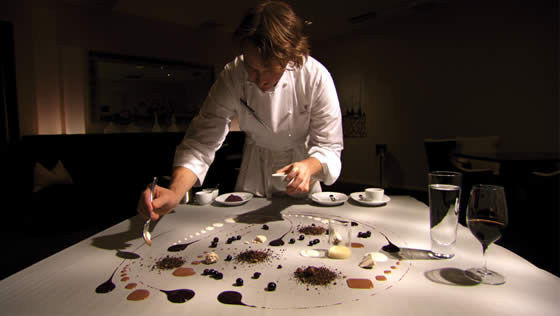 There have been some classic gastronomy documentaries in these days of Cuisine as Event: David Gelb’s 2009 “Jiro Dreams Of Sushi” and Gereon Wetzel’s 2011 “El Bulli: Cooking in Progress. Joseph Levy’s “Spinning Plates” takes another tack, focusing on three very different restaurants, and in the process reflecting class differences in the new Globalized world. It is also a meditation on the meaning to these restaurateurs of serving food, and how they see themselves in their individual communities.
There have been some classic gastronomy documentaries in these days of Cuisine as Event: David Gelb’s 2009 “Jiro Dreams Of Sushi” and Gereon Wetzel’s 2011 “El Bulli: Cooking in Progress. Joseph Levy’s “Spinning Plates” takes another tack, focusing on three very different restaurants, and in the process reflecting class differences in the new Globalized world. It is also a meditation on the meaning to these restaurateurs of serving food, and how they see themselves in their individual communities.
Each of the three restaurants, which are linked emotionally in the last act, hides some fascinating human dramas. (No spoilers here!)
Chef Grant Achatz, who grew up in a rural setting as the son of a small restaurant owner, has arrived at the top of the heap. Beginning as a chef de parti and eventually sous-chef for Thomas Keller of famed The French Laundry in Yountville, California, Achatz also worked at Charlie Trotter’s before launching Alinea. Achatz credits both Trotter and Keller as icons and influences, although he parted with Trotter on unfriendly terms.
His very personal molecular gastronomy, or modernist restaurants serves up memories condensed through the scientific equipment that is the core of Molecular Gastronomy. Burnt leaves and vapor of cigarettes waft over his special miniscule dishes, each a sculptural delight.
Gourmet magazine named Alinea the best restaurant in America in “America’s Top 50 Restaurants” 2007. In 2007, Restaurant magazine added Alinea to it’s list of the 50 best restaurants in the world at number 36, the highest new entry of the year. By the time the film is over Achatz’s Alinea has achieved 3-star Michelin status, one of two restaurants in Chicago to receive that coveted top rating, and he has launched the sold-out new restaurant Next. Partner Nick Kokonas and his wife and sons also feature in the film.
Next we meet Mike Breitbach and family, owners and workers at Iowa’s oldest food and drinking establishment (opened in 1852) operated by Mike’s great-great grandfather, Jacob Breitbach, who worked for the original owner and purchased the tavern in 1862.
The rural town of Balltown grew up around its beloved restaurant, which has morphed into both a nationally beloved restaurant and a community center. Aging elders have keys, show up in the morning and start the coffee, checking in on each other each day. When disaster struck, as you will see in the film, fans and friends rallied from all over the state. Mike and his family are the social glue of the community, taking their responsibility very seriously; they deliver food to aged friends and relatives, even mowing lawns for the handicapped. Breitbach’s family and friends are inspiring.
The last restaurant, a humble neighborhood home- style Mexican restaurant in Tucson- La Cocina de Gabby. puts the whole Martinez family to work. Doting husband, blue-collar worker Francisco Martinez created the restaurant for his beloved wife Gabby, who “cooks like an angel.” She sold her jewelry to help pay for the start-up. Fighting off foreclosure, the family works together, including Gabby’s sister and mother, cooking three generations of Mexican food, including innovative breakfast burritos. All to sustain the family and pay for their three year old Ashley’s schooling. Joseph Levy’s portraits of three vastly different, yet spiritually connected restaurants is food for thought. A MUST SEE

